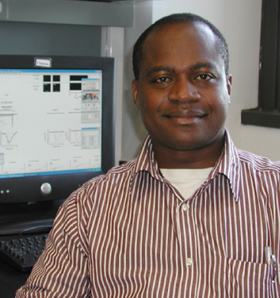Targeting Excitable Cells
Biophysicist Henry Colecraft, Ph.D., recently arrived from Johns Hopkins University to set up the Calcium Channel Physiology Lab, where he will continue his work on the heart’s calcium channels. He is the Wu Center’s first new recruit. “He comes highly recommended by international scientists,” says Dr. Andy Marks. “I decided to recruit him after hearing his lecture at a Gordon Conference a year ago.” The Gordon Conferences have been held since the 1920s to promote discussions and the free exchange of ideas at the research frontiers of the biological, chemical and physical sciences. Interdisciplinary cross-fertilization is integral to Columbia’s new Cardiovascular Research Initiative as well. While being interviewed for Heart Horizons, Dr. Colecraft had to stop to direct the telephone installer where to put a phone in his new Columbia lab. He’s used to relocating, but this is the first time he’s moved his lab. Born in Ghana, he lived in Boston while his father attended Harvard, went to London for his undergrad degree in Physiology, followed by a doctorate from the University of Rochester (New York) and post doctoral studies at Hopkins where he became an Assistant Professor of Biomedical Engineering. No Ordinary Gimmick Calcium channels are a popular target for drugs treating diseases such as hypertension, arrhythmias, and pain, but Dr. Colecraft has a new gimmick. Make that a GEMIICC, an acronym for Genetically Encoded Molecules for Inducibly Inhibiting Calcium Channels. GEMIICCs are proteins that can be acutely activated with a chemical agent to turn off calcium channels and have both research and therapeutic applications in the cardiovascular system and beyond. The combination of chemical and genetic regulation built into the GEMIICCs potentially makes them more selective calcium channel blockers than traditional drugs. Right now Dr. Colecraft’s lab is seeking to move the GEMIICC technology beyond the proof-of-concept stage to applications in animals. Dr. Colecraft reminds the interviewer that millions of cells must be coordinated to make the heart beat. This is achieved through the use of electrical signals which are one of the fastest communication modes in biology. The calcium channels reside on the heart cells and open in response to the electrical messages. This allows calcium to flow into the cells to trigger the heart’s contraction. |
"with the advent of stem cell research, we have the potential of regenerating a broken heart"
|


